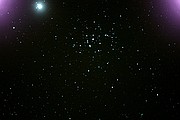
Photography results:
A Canon 1D digital camera was mounted to the lens. The resulting F.O.V. was
approximately 3 degrees (1.5 degrees with the doubler). The maximum exposure
with this unit is 30 seconds. The effective exposure was 27 seconds, when
the "hat trick" method was used to block light trails of initial vibration.
ISO sensitivity was in the 1250 range for most of the photos.
Focus was done by the camera (EOS passive autofocus system). In some cases this proved inadequate.
M44 Beehive Cluster with Jupiter. This is the first object attempted. The tracking went well - there was some slippage. The focus is off. However, the image includes far more stars than the necessarily short, untracked exposure. 2003.04.24 23:04:05 400.0 mm 20 sec, f/2.8 Mode: Manual Metering: Center-weighted average ISO: 1600 AF mode: Manual Focus Drive: Continuous (high): frame 1 White balance: Auto Color matrix 1: sRGB natural-looking hue and chroma Flash: Off File size: 2,658KB Image size: 2464 x 1648 Sharpness level: Off Custom Functions: CFn 3: Extended ISO sensitivity
M13 Globular Cluster in Hercules at 27 seconds. Individual stars were resolved. 2003.04.25 01:02:35 800.0 mm 30 sec, f/5.7 Mode: Manual Metering: Center-weighted average ISO: 1600 AF mode: Manual Focus Drive: Continuous (high): frame 1 White balance: Auto Color matrix 1: sRGB natural-looking hue and chroma Flash: Off File size: 1,929KB Image size: 2464 x 1648 Sharpness level: Off Custom Functions: CFn 3: Extended ISO sensitivity
M44 Beehive Cluster in Cancer. 2003.04.25 01:10:53 800.0 mm 30 sec, f/5.7 Mode: Manual Metering: Center-weighted average ISO: 1600 AF mode: Manual Focus Drive: Continuous (high): frame 1 White balance: Auto Color matrix 1: sRGB natural-looking hue and chroma Flash: Off File size: 2,450KB Image size: 2464 x 1648 Sharpness level: Off Custom Functions: CFn 3: Extended ISO sensitivity
Two views of M7 Ptolemy Cluster in Scorpius. 1: 2003.04.25 01:15:37 800.0 mm 30 sec, f/5.7 Mode: Manual Metering: Center-weighted average ISO: 1250 AF mode: Manual Focus Drive: Continuous (high): frame 1 White balance: Auto Color matrix 1: sRGB natural-looking hue and chroma Flash: Off File size: 2,358KB Image size: 2464 x 1648 Sharpness level: Off Custom Functions: CFn 3: Extended ISO sensitivity.2: 2003.04.25 01:14:24 800.0 mm 30 sec, f/5.7 Mode: Manual Metering: Center-weighted average ISO: 1600 AF mode: Manual Focus Drive: Continuous (high): frame 1 White balance: Auto Color matrix 1: sRGB natural-looking hue and chroma Flash: Off File size: 2,569KB Image size: 2464 x 1648 Sharpness level: Off Custom Functions: CFn 3: Extended ISO sensitivity
M6 Butterfly Cluster in Scorpius. 1: 2003.04.25 01:20:19 800.0 mm 30 sec, f/5.7 Mode: Manual Metering: Center-weighted average ISO: 1250 AF mode: Manual Focus Drive: Continuous (high): frame 1 White balance: Auto Color matrix 1: sRGB natural-looking hue and chroma Flash: Off File size: 2,098KB Image size: 2464 x 1648 Sharpness level: Off Custom Functions: CFn 3: Extended ISO sensitivity. 2: 2003.04.25 01:18:34 800.0 mm 30 sec, f/5.7 Mode: Manual Metering: Center-weighted average ISO: 1250 AF mode: Manual Focus Drive: Continuous (high): frame 1 White balance: Auto Color matrix 1: sRGB natural-looking hue and chroma Flash: Off File size: 2,131KB Image size: 2464 x 1648 Sharpness level: Off Custom Functions: CFn 3: Extended ISO sensitivity
M8 Lagoon Nebula in Sagittarius. 2003.04.25 01:27:21 800.0 mm 30 sec, f/5.7 Mode: Manual Metering: Center-weighted average ISO: 1250 AF mode: Manual Focus Drive: Continuous (high): frame 1 White balance: Auto Color matrix 1: sRGB natural-looking hue and chroma Flash: Off File size: 2,123KB Image size: 2464 x 1648 Sharpness level: Off Custom Functions: CFn 3: Extended ISO sensitivity
Mizar and Alcor in Ursa Major. 2003.04.24 23:26:08 800.0 mm 10 sec, f/5.7 Mode: Manual Metering: Center-weighted average ISO: 1250 AF mode: Manual Focus Drive: Continuous (high): frame 1 White balance: Auto Color matrix 1: sRGB natural-looking hue and chroma Flash: Off File size: 1,661KB Image size: 2464 x 1648 Sharpness level: Off Custom Functions: CFn 3: Extended ISO sensitivity
Nova in Sagittarius v4743 No 3. This was the last object of the night. By now, we had the tracking pretty much stabilized. Nova v4743, having first been seen on 21 SEP 2002 at mag 5.5, has now diminished to ~12. It is thought the light may be being attenuated by nebular gas expelled from the explosion. Hubble should be pointed at this thing to see if any early planetary nebula development can be recorded. Tracking was exact. Note that stars can be seen down to 13 magnitude [refer to chart] in this 27-second exposure. 2003.04.25 01:31:2 800.0 mm 30 sec, f/5.7 Mode: Manual Metering: Center-weighted average ISO: 1250 AF mode: Manual Focus Drive: Continuous (high): frame 1 White balance: Auto Color matrix 1: sRGB natural-looking hue and chroma Flash: Off File size: 2,073KB Image size: 2464 x 1648 Sharpness level: Off Custom Functions: CFn 3: Extended ISO sensitivity
All exposures Canon EOS 1D, mounted on a Meade LXD300 eq mount. Image postprocessing included crop, resize and despeckle, and unsharp mask.
Further refinements specific to the Canon long lenses.
Conclusion:
The preliminary results are satisfactory. The limitation of using this type
of telephoto lens in astrophotography seems that precise focus is
difficult, due to the internal focuser being designed for high speed instead
of high precision. This can be overcome using a magnifying viewfinder. The
mount worked very well and we anticipate improved images as our technique
is refined.